Insights into the Modifying Effect of Ga on Cu-Based Catalysts for Hydrogenation of Hydroxypivalaldehyde to Neopentyl Glycol
Abstract
:1. Introduction
2. Experimental
2.1. Materials and Methods
2.2. Catalyst Preparation
2.3. Catalyst Characterization
2.4. Measurement of Catalytic Activity
3. Results
3.1. Catalytic Activity and Stability
3.2. XRD Characterization
3.3. H2-TPR Analysis
3.4. XPS Test Analysis
4. Discussion
5. Conclusions
Author Contributions
Funding
Data Availability Statement
Conflicts of Interest
References
- Aguieiras, E.C.G.; Cavalcanti, E.D.C.; Silva, d.P.R.; Soares, V.F.; Fernandez-Lafuente, R.; Assunçao, C.L.B.; Silva, d.J.A.C.; Freire, D.M.G. Enzymatic synthesis of neopentyl glycol-bases biolubricants using biodiesel from soybean and castor bean as raw materials. Renew. Energ. 2020, 148, 689–696. [Google Scholar] [CrossRef]
- Nousiainen, H. US06545189B1; Process for the preparation of neopentyl glycol; Neste Chemicals Oy: Espoo, Finland, 2003. [Google Scholar]
- Monasterska, E.; Chrobok, A.; Pankalla, E.; Siewniak, A. Development of Methods for the Synthesis of Neopentyl Glycol by Hydrogenation of Hydroxypivaldehyde. Molecules 2021, 26, 5822. [Google Scholar] [CrossRef] [PubMed]
- Verma, D.; Insyani, R.; Cahyadi, H.S.; Park, J.Y.; Kim, S.M.; Chao, S.M.; Bae, J.W.; Kim, J. Ga-doped Cu/H-nanozeolite-Y catalyst for selective hydrogenation and hydrodeoxygenation of lignin-derived chemicals. Green Chem. 2018, 20, 3253–3270. [Google Scholar] [CrossRef]
- Kalong, M.; Srifa, A.; Hongmanorom, P.; Cholsuk, C.; Klysubun, W.; Ratchahat, S.; Koo-Amornpattana, W.; Khemthong, P.; Assabumrungrat, S.; Kawi, S. Catalytic transfer hydrogenation of furfural to furfuryl alcohol and 2-methylfuran over CuFe catalysts: Ex situ observation of simultaneous structural phase transformation. Fuel Process. Technol. 2022, 231, 107256. [Google Scholar] [CrossRef]
- Lan, X.C.; Xue, K.C.; Wang, T.F. Combined synergetic and steric effects for highly selective hydrogenation of unsaturated aldehyde. J. Catal. 2019, 372, 49–60. [Google Scholar] [CrossRef]
- Witoon, T.; Numpilai, T.; Phongamwong, T.; Donphai, W.; Boonyuen, C.; Warakulwit, C.; Chareonpanich, M.; Limtrakul, J. Enhanced activity, selectivity and stability of a CuO-ZnO-ZrO2 catalyst by adding graphene oxide for CO2 hydrogenation to methanol. Chem. Eng. J. 2018, 334, 1781–1791. [Google Scholar] [CrossRef]
- Yang, W.T.; Li, A.T.; Yang, Y.W.; Hai, Y.H.; Zhen, Z.H.; Li, Z.S.; Lv, J.; Wang, Y.; Ma, X.B. Low-Temperature Hydrogenation of Methyl Acetate to Ethanol over a Manganese-Modified Cu/SiO2 Catalyst. Ind. Eng. Chem. Res. 2022, 61, 11718–11726. [Google Scholar] [CrossRef]
- He, Z.; Lin, H.Q.; He, P.; Yuan, Y.Z. Effect of boric oxide doping on the stability and activity of a Cu–SiO2 catalyst for vapor-phase hydrogenation of dimethyl oxalate to ethylene glycol. J. Catal. 2011, 277, 54–63. [Google Scholar] [CrossRef]
- Chen, H.B.; Liao, D.W.; Yu, L.J.; Lin, Y.J.; Yi, J.; Zhang, H.B.; Tsai, T.R. Influence of trivalent metal ions on the surface structure of a copper-based catalyst for methanol synthesis. Appl. Surf. Sci. 1999, 147, 85–93. [Google Scholar] [CrossRef]
- Song, H.T.; Fazelia, A.; Kim, H.D.; Eslami, A.A.; Noh, Y.S.; Saeidabad, N.G.; Moon, D.J. Effect of lanthanum group promoters on Cu/(mixture of ZnO and Zn-Al-spinnel-oxides) catalyst for methanol synthesis by hydrogenation of CO and CO2 mixtures. Fuel 2021, 283, 118987. [Google Scholar] [CrossRef]
- Wang, Y.; Shen, Y.; Zhao, Y.; Lv, J.; Wang, S.; Ma, X. Insight into the Balancing Effect of Active Cu Species for Hydrogenation of Carbon—Oxygen Bonds. ACS Catal. 2015, 5, 6200–6208. [Google Scholar] [CrossRef]
- Sun, K.; Bian, Z.K.; Cheng, S.Y.; Wang, G.R.; Zhang, L.; Huang, W. Effect of Si content on the performance of direct synthesis of dimethyl ether over slurry CuZnAl catalyst prepared by complete liquid phase technology. J. Fuel Chem. Technol. 2021, 49, 791–798. [Google Scholar] [CrossRef]
- Fujitani, T.; Saito, M.; Kanai, Y.; Kakumoto, T.; Watanabe, T.; Nakamura, J.; Uchijima, T. The role of metal oxides in promoting a copper catalyst for methanol synthesis. Catal. Lett. 1994, 25, 271–276. [Google Scholar] [CrossRef]
- Si, C.C.; Ban, H.Y.; Chen, K.; Wang, X.; Cao, R.; Yi, Q.; Li, C. Insight into the positive effect of Cu0/Cu+ ratio on the stability of Cu-ZnO-CeO2 catalyst for syngas hydrogenation. Appl. Catal. A Gen. 2020, 594, 117466. [Google Scholar] [CrossRef]
- Kang, S.H.; Bae, J.W.; Prasad, P.S.S.; Oh, J.H.; Jun, K.W.; Song, S.L.; Min, K.S. Influence of Ga addition on the methanol synthesis activity of Cu/ZnO catalyst in the presence and absence of alumina. J. Ind. Eng. Chem. 2009, 15, 665–669. [Google Scholar] [CrossRef]
- Grunwaldt, J.D.; Molenbroek, A.M.; Topsoe, A.-Y.; Topsoe, H.; Clausen, B.C. In Situ Investigations of Structural Changes in Cu/ZnO Catalysts. J. Catal. 2000, 194, 452–460. [Google Scholar] [CrossRef]
- Wang, F.; Liu, Y.W.; Gan, Y.H.; Ding, W.; Fang, W.P.; Yang, Y.Q. Study on the modification of Cu-based catalysts with cupric silicate for methanol synthesis from synthesis gas. Fuel Process. Technol. 2013, 110, 190–196. [Google Scholar] [CrossRef]
- Toyir, J.; De La Piscina, P.R.; Fierro, J.L.G.; Homs, N. Catalytic performance for CO2 conversion to methanol of gallium-promoted copper-based catalysts: Influence of metallic precursors. Appl. Catal. B Environ. 2001, 34, 255–266. [Google Scholar] [CrossRef]
- Guo, X.M.; Mao, D.S.; Lu, G.Z.; Wang, S.; Wu, G.S. Glycine-nitrate combustion synthesis of CuO-ZnO-ZrO2 catalysts for methanol synthesis from CO2 hydrogenation. J. Cataly. 2010, 271, 178–185. [Google Scholar] [CrossRef]
- Chary, K.V.R.; Seela, K.K.; Sagar, G.V.; Sreedhar, B. Characterization and Reactivity of Niobia Supported Copper Oxide Catalysts. J. Phys. Chem. B 2004, 108, 658–663. [Google Scholar] [CrossRef]
- Avgouropoulos, G.; Ioannides, T.; Matralis, H. Influence of the preparation method on the performance of CuO-CeO2 catalysts for the selective oxidation of CO. Appl. Catal. B Environ. 2005, 56, 87–93. [Google Scholar] [CrossRef]
- Lunkenbein, T.; Schumann, J.; Behrens, M.; Schlögl, R.; Willinger, M.G. Formation of a ZnO Overlayer in Industrial Cu/ZnO/Al2O3 Catalysts Induced by Strong Metal-Support Interactions Angew. Chem. Int. Ed. 2015, 54, 4544–4548. [Google Scholar] [CrossRef] [PubMed]
- Zheng, J.W.; Huang, L.L.; Cui, C.H.; Chen, Z.C.; Liu, X.F.; Duan, X.; Zheng, L.S. Ambient-pressure synthesis of ethylene glycol catalyzed by C60-buffered Cu/SiO2. Science 2022, 376, 288–292. [Google Scholar] [CrossRef] [PubMed]
- Narkhede, N.; Zheng, H.Y.; Zhang, H.C.L.; Zhang, G.Q.; Li, Z. Group 13 metal doped Cu/ZnO catalysts from phase pure precursors via an isomorphous substitution route: Mechanistic insights into promotional effects for syngas hydrogenation to methanol. Catal. Sci. Technol. 2020, 10, 7386. [Google Scholar] [CrossRef]
- Liu, Z.; An, X.Q.; Song, M.; Wang, Z.J.; Wei, Y.F.; Mintova, S.; Giordano, G.; Yan, Z.F. Dry gel assisting crystallization of bifunctional CuO-ZnO-Al2O3/SiO2-Al2O3 catalysts for CO2 hydrogenation. Biomass. Bioenerg. 2022, 163, 106525. [Google Scholar] [CrossRef]
- Gu, Y.T.; Han, C.; Huang, J.H.; Vinokurov, V.A.; Huang, W. CuZnAlOOH catalysts with Cu0/Cu+ constructed by two-step hydrolysis for ethanol production from syngas. Fuel 2022, 322, 124111. [Google Scholar] [CrossRef]
- Ye, R.; Lin, L.; Yang, J.; Sun, M.; Li, F.; Li, B.; Yao, Y. A new low-cost and effective method for enhancing the catalytic performance of Cu–SiO2 catalysts for the synthesis of ethylene glycol via the vapor-phase hydrogenation of dimethyl oxalate by coating the catalysts with dextrin. J. Catal. 2017, 350, 122–132. [Google Scholar] [CrossRef]
- Rao, R.S.; Baker, R.; Terry, K.; Vannice, M.A. Furfural hydrogenation over carbon-supported copper. Catal. Lett. 1999, 60, 51–57. [Google Scholar] [CrossRef]
- Liu, X.M.; Lu, G.Q.; Yan, Z.F.; Beltramini, J. Assessment of economic considerations for air pollution control technologies. Ind. Eng. Chem. Res. 2003, 42, 6518–6530. [Google Scholar] [CrossRef]
- Ai, P.P.; Tan, M.H.; Reubroycharoen, P.; Wang, Y.; Feng, X.B.; Liu, G.G.; Yang, G.H.; Tsubaki, N. Catalytic Hydrogenation of Benzaldehyde for Selective Synthesis of Benzyl Alcohol: A Review. Catal. Sci. Technol. 2018, 8, 6441–6451. [Google Scholar] [CrossRef]
- Bhanushali, J.T.; Kainthla, I.; Keri, R.S.; Nagaraja, B.M. Probing the promotional roles of cerium in the structure and performance of Cu/SiO2 catalysts for ethanol production. ChemistrySelect 2016, 1, 3839–3853. [Google Scholar] [CrossRef]
- Zhang, J.X.; Wu, D.F. Aqueous phase catalytic hydrogenation of furfural to furfuryl alcohol over in-situ synthesized Cu-Zn/SiO2 catalysts, Mater. Chem. Phys. 2021, 260, 124152. [Google Scholar]


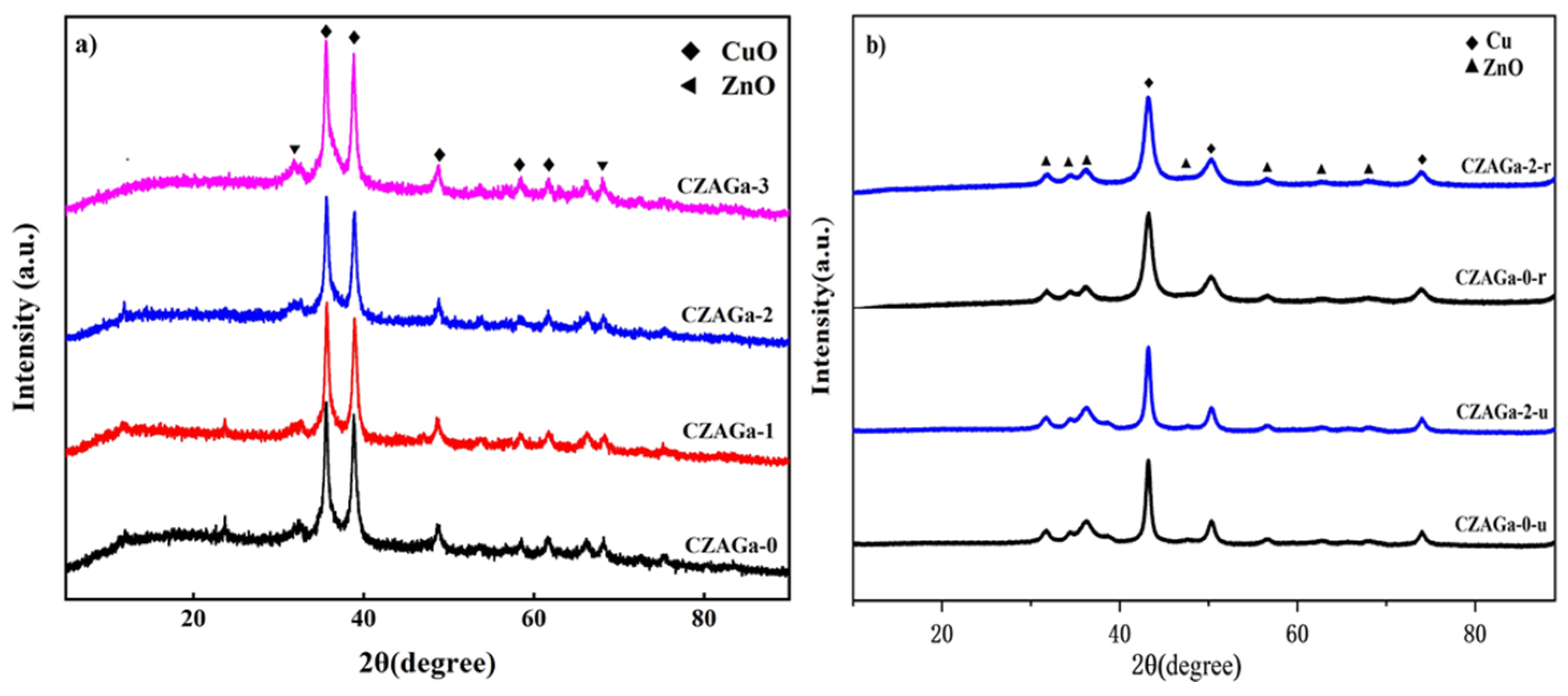
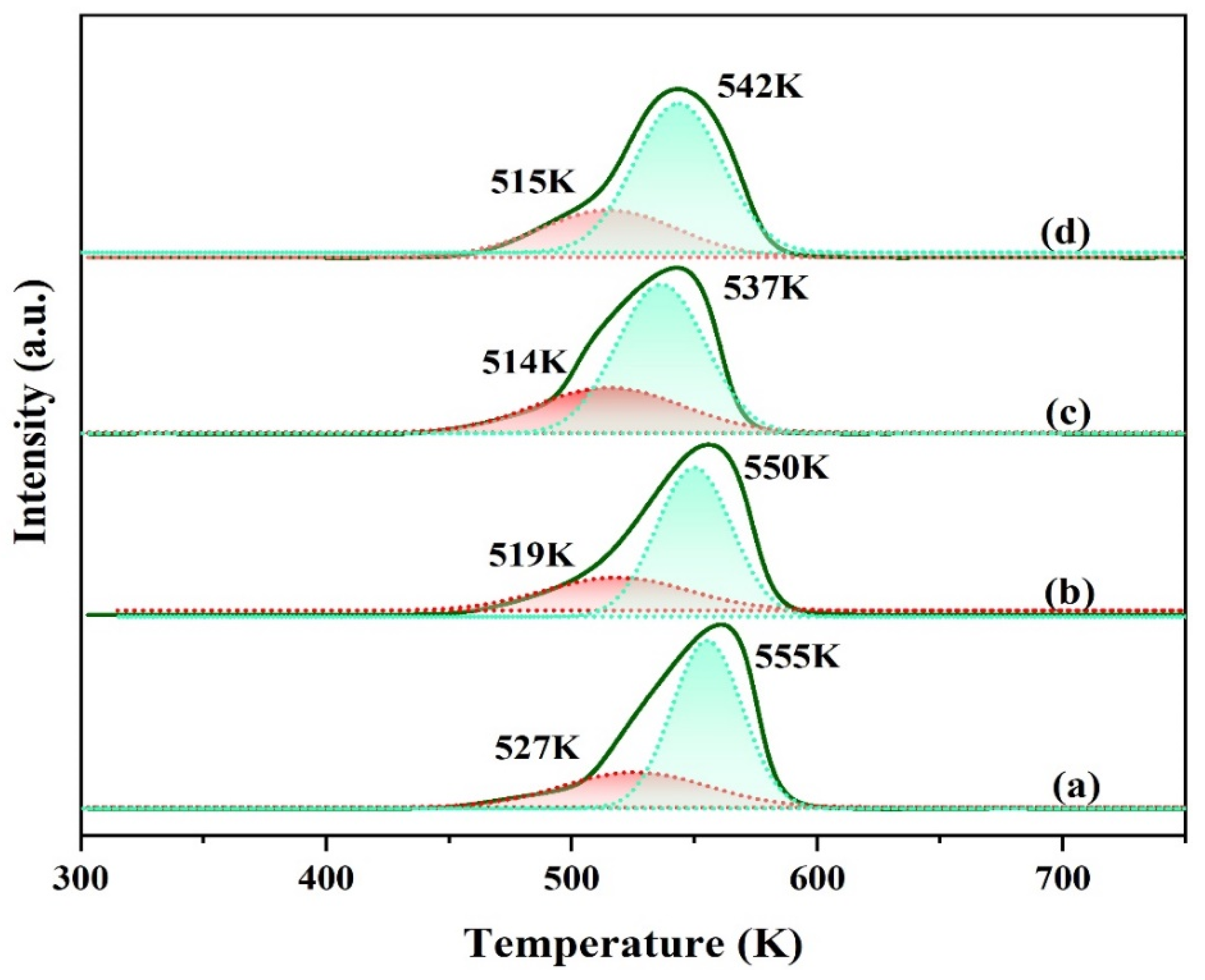
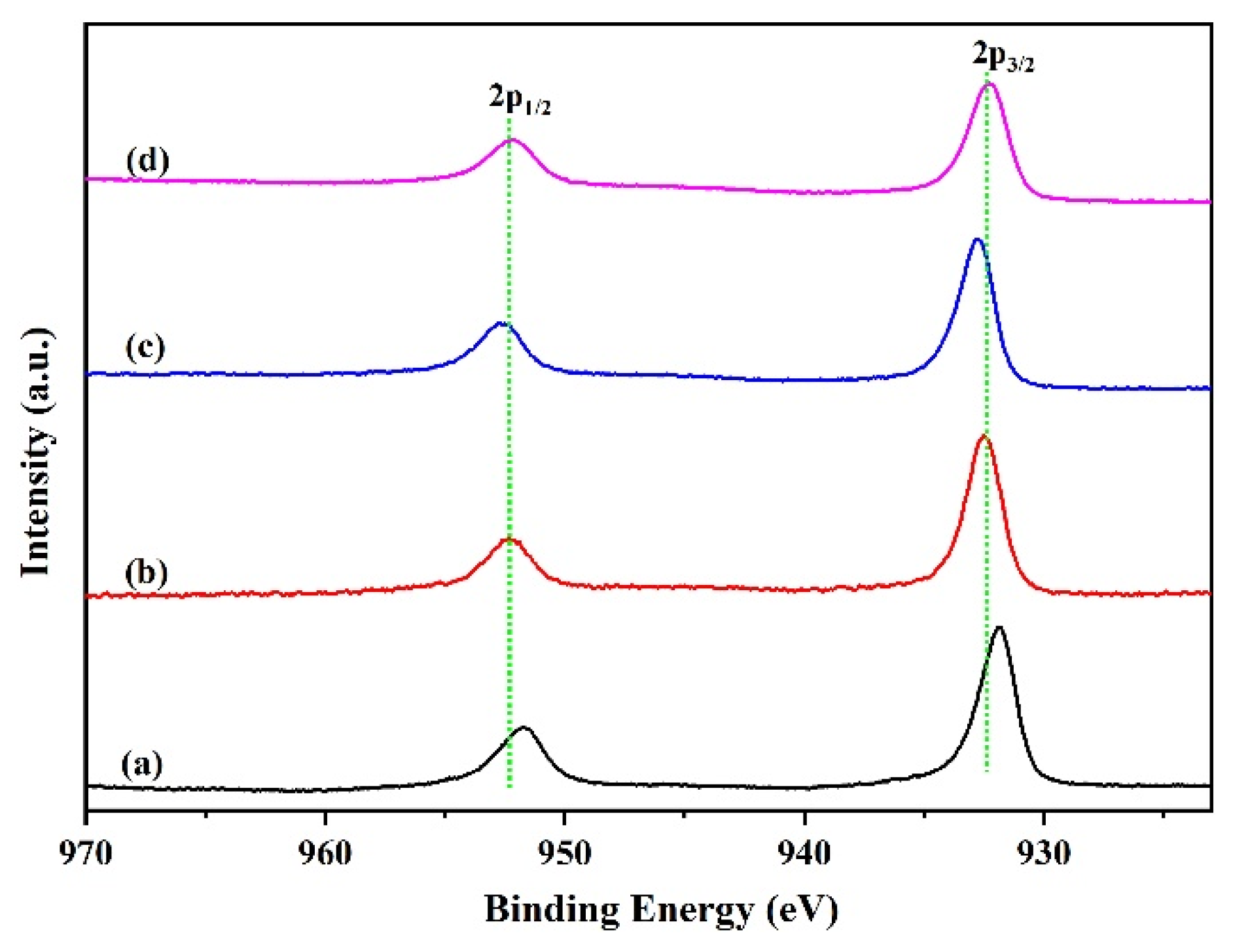
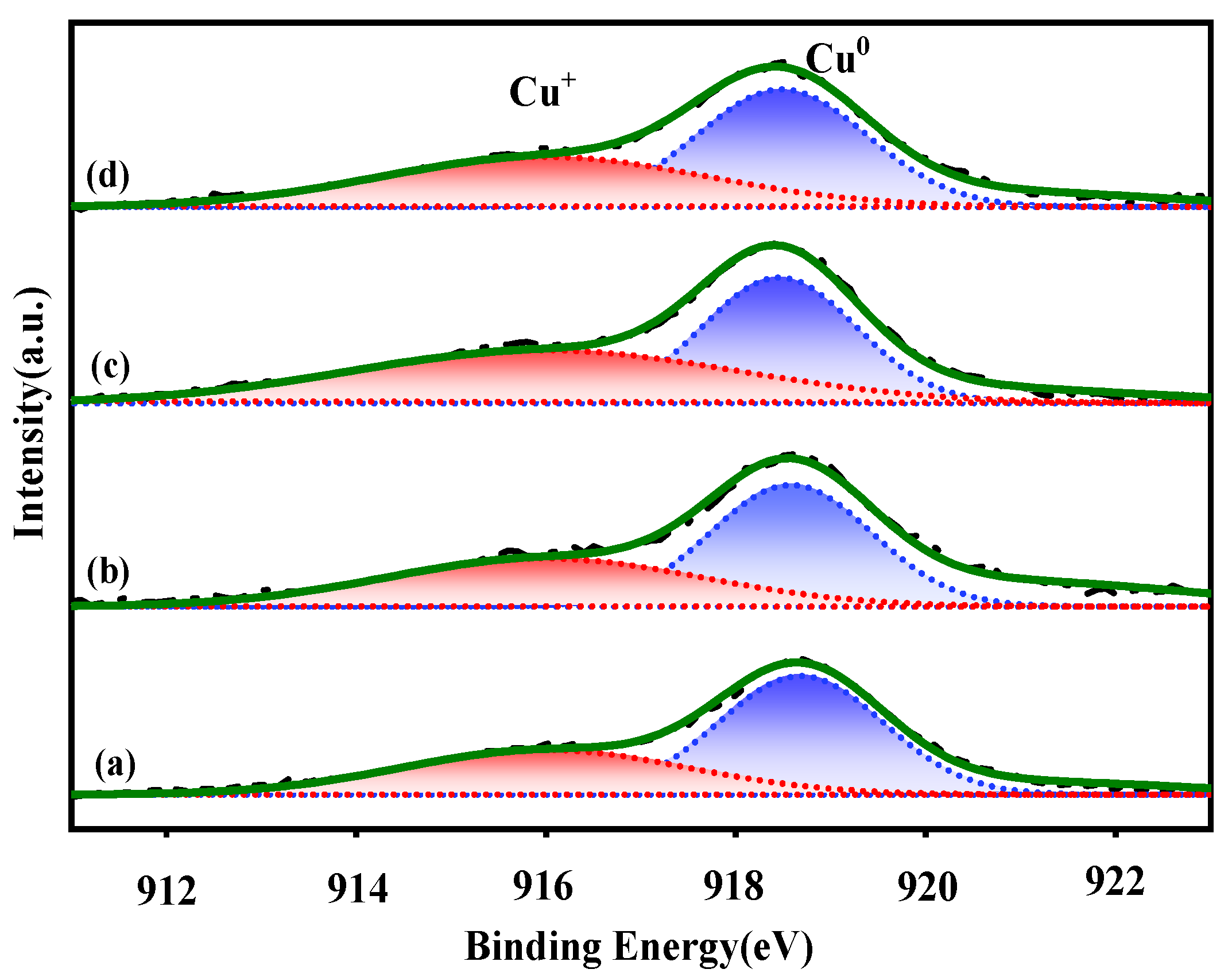
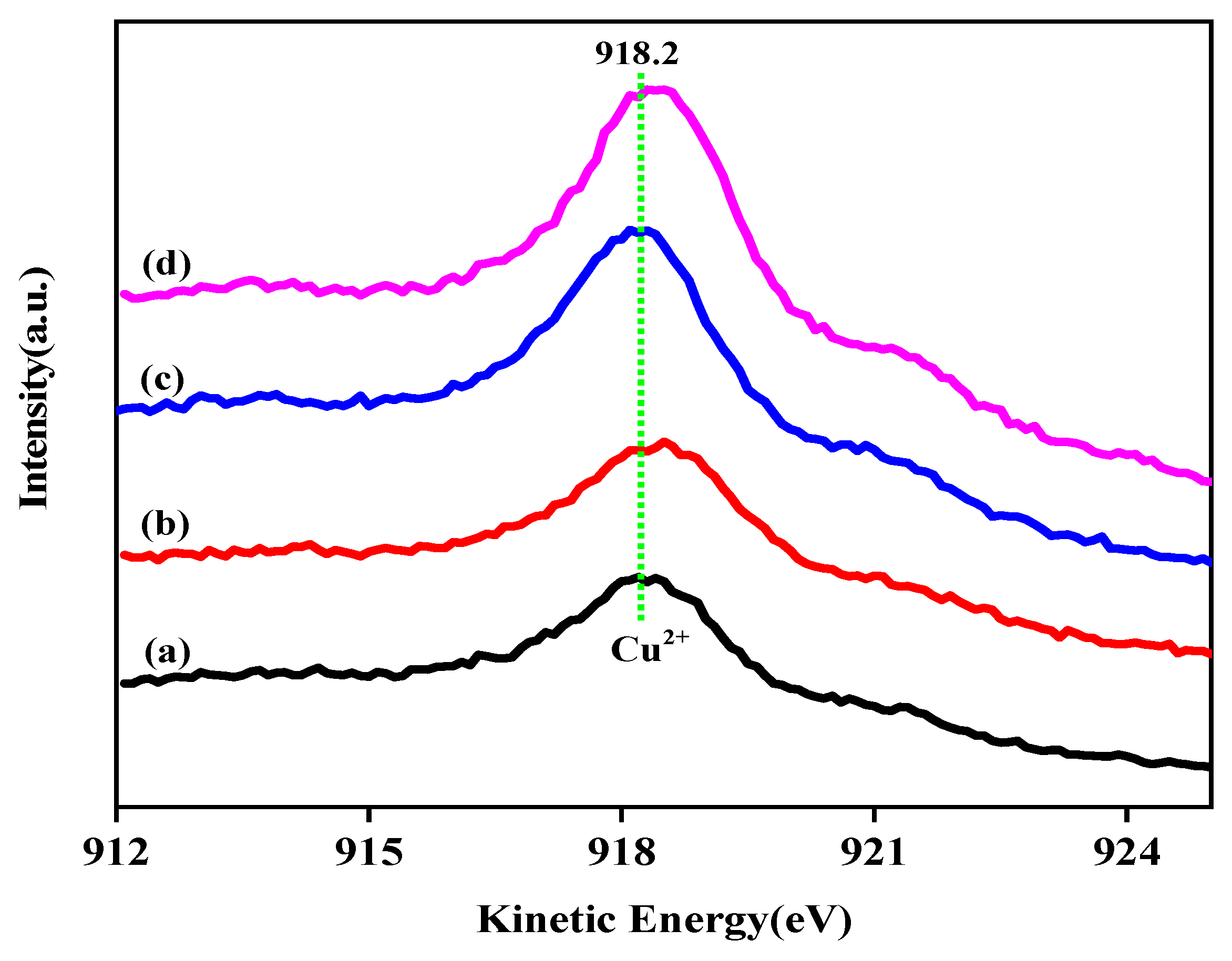

| Catalyst | SBET (m2/g) | Pore Vol. (cm3/g) | Cu Surface Area (m2/gCu) | CuO Particle Size (nm) | HPA Conv. (%) | Sel. (%) NPG HPHP | |
|---|---|---|---|---|---|---|---|
| CZAGa-0 | 46.1 | 0.13 | 23.5 | 18.7 | 81.2 | 87.8 | 4.2 |
| CZAGa-1 | 42.8 | 0.13 | 25.6 | 18.1 | 89.5 | 90.6 | 3.9 |
| CZAGa-2 | 45.4 | 0.12 | 30.9 | 18.5 | 93.5 | 95.5 | 2.6 |
| CZAGa-3 | 47.6 | 0.11 | 28.2 | 19.6 | 91.9 | 93.1 | 3.2 |
| Catalysts | Kinetic Energy (eV) | B. E. of Cu2p3/2 (eV) | Peak Area Ratios, Cu+/ (Cu+ + Cu0) | |
|---|---|---|---|---|
| Cu+ | Cu0 | |||
| CZAGa-0 | 916.1 | 918.3 | 931.8 | 0.26 |
| CZAGa-1 | 916.2 | 918.4 | 932.5 | 0.28 |
| CZAGa-2 | 916.2 | 918.4 | 932.7 | 0.35 |
| CZAGa-2 | 916.2 | 918.5 | 932.3 | 0.32 |
Disclaimer/Publisher’s Note: The statements, opinions and data contained in all publications are solely those of the individual author(s) and contributor(s) and not of MDPI and/or the editor(s). MDPI and/or the editor(s) disclaim responsibility for any injury to people or property resulting from any ideas, methods, instructions or products referred to in the content. |
© 2023 by the authors. Licensee MDPI, Basel, Switzerland. This article is an open access article distributed under the terms and conditions of the Creative Commons Attribution (CC BY) license (https://creativecommons.org/licenses/by/4.0/).
Share and Cite
Zhu, J.; Liu, H.; Zhou, X.; Wang, Z.; Bing, L.; Han, D.; Wang, G.; Wang, F. Insights into the Modifying Effect of Ga on Cu-Based Catalysts for Hydrogenation of Hydroxypivalaldehyde to Neopentyl Glycol. Catalysts 2023, 13, 673. https://doi.org/10.3390/catal13040673
Zhu J, Liu H, Zhou X, Wang Z, Bing L, Han D, Wang G, Wang F. Insights into the Modifying Effect of Ga on Cu-Based Catalysts for Hydrogenation of Hydroxypivalaldehyde to Neopentyl Glycol. Catalysts. 2023; 13(4):673. https://doi.org/10.3390/catal13040673
Chicago/Turabian StyleZhu, Jinghu, Hui Liu, Xueyan Zhou, Zhijun Wang, Liancheng Bing, Dezhi Han, Guangjian Wang, and Fang Wang. 2023. "Insights into the Modifying Effect of Ga on Cu-Based Catalysts for Hydrogenation of Hydroxypivalaldehyde to Neopentyl Glycol" Catalysts 13, no. 4: 673. https://doi.org/10.3390/catal13040673
APA StyleZhu, J., Liu, H., Zhou, X., Wang, Z., Bing, L., Han, D., Wang, G., & Wang, F. (2023). Insights into the Modifying Effect of Ga on Cu-Based Catalysts for Hydrogenation of Hydroxypivalaldehyde to Neopentyl Glycol. Catalysts, 13(4), 673. https://doi.org/10.3390/catal13040673







